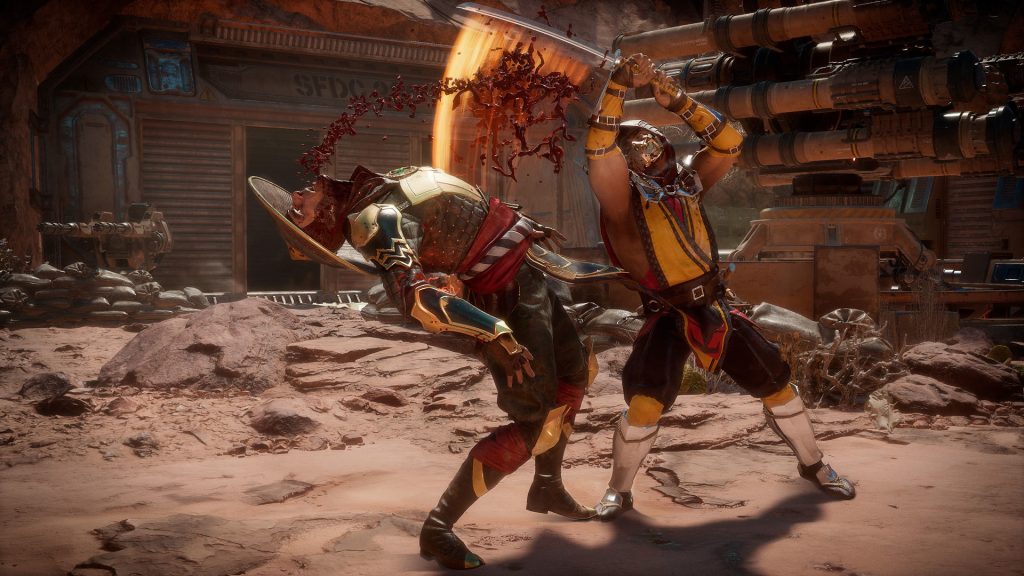10.5 Controversial Issues
The increasing realism and expanded possibilities of video games have sparked considerable controversy. However, even early games, though rudimentary and seemingly laughable nowadays, raised controversy over their depiction of adult themes. Although the increased realism and graphics capabilities of contemporary video games have heightened the shock value of in-game violence, international culture has struggled to come to terms with video game violence since the inception of video games.
Violence


Violence in video games has created controversy from its earliest days. Death Race, an arcade game released in 1976, encouraged drivers to run over stick figures, which then turned into tombstone Xs. Although the programmers claimed that the stick figures did not depict humans, the game caused controversy, making national news on the TV talk show Donahue and the TV news magazine 60 Minutes. Video games, regardless of their level of realism, have added a new dimension to the world of gaming and entertainment: the ability to simulate violence, including murder.
A rise in violent games accompanied the enhanced realism of video games in the 1990s as companies expanded their market to target older demographics. A great deal of controversy exists over the influence of this kind of violence on children. Critics linked real-life violent acts like the 1999 Columbine High School massacre to the teenage perpetrators’ enthusiasm for video games. The families of Columbine victims brought a lawsuit against 25 video game companies, claiming that if the games had not existed, the massacre would not have happened (Ward, 2001). In 2008, a 17-year-old boy shot his parents after they took away his video game system, killing his mother (Harvey, 2009). Also in 2008, six teens arrested for attempted carjacking and robbery stated that they had tried to re-enact scenes from Grand Theft Auto (Cochran, 2008). Several other high-profile acts of violence (including the Uvalde School shooting, where parents have sued Call of Duty maker Activision) have reignited this discussion. Following the devastating Sandy Hook Elementary School shooting in 2012, and subsequent tragedies like the Munich Olympia Mall shooting in 2016, the Parkland school shooting in 2018, and mass shootings in the U.S. and abroad in 2019 (including El Paso, Dayton, Suzano, and Halle), video games have repeatedly been drawn into the public discourse as a potential contributing factor.
However, the scientific community’s understanding of this complex issue has undergone significant evolution. While these incidents understandably provoke intense public concern, leading scientific organizations, including the American Psychological Association, have consistently maintained that there is no conclusive evidence to establish a direct causal link between violent video game play and real-world violent criminal behavior. Research often indicates a small, reliable correlation between violent video game use and aggressive behaviors such as increased aggressive thoughts, angry feelings, or minor physical aggression (like yelling or pushing). Yet, experts emphasize that these findings do not translate to severe acts of violence like mass shootings. They argue that attributing such complex acts solely to video game exposure is not scientifically sound and often diverts attention from other, more significant contributing factors, including pre-existing psychological conditions, social isolation, access to weapons, and broader societal issues. Critics also frequently point out that individuals who commit video-game-related crimes may already possess psychopathic tendencies, suggesting that a naturally violent predisposition might lead them to seek out violent media, rather than the press causing the violence itself (Adams, 2010). This perspective highlights correlation over causation.
In December 1993 and March 1994, Sega of America, represented by Vice President Bill White, testified before the United States Senate committees during hearings on violence in video games, which were sparked mainly by the graphic fatalities in Mortal Kombat and the full-motion video horror of Night Trap. While Nintendo advocated for a more family-friendly approach and censored its version of Mortal Kombat, Sega defended its games as suitable entertainment for adults. It highlighted its self-developed Video Game Rating Council (VRC), which had already assigned ratings such as MA-13 and MA-17 to titles on its Genesis platform. These hearings, led by Senators Joe Lieberman and Herb Kohl, ultimately pressured the video game industry to establish a unified, independent rating system, leading to the creation of the Entertainment Software Rating Board (ESRB) in 1994.
The challenge of regulating children’s access to violent games remains a complex issue, partly due to inconsistencies in content rating systems across different media. The ESRB employs ratings such as “M” (Mature, 17+) and “AO” (Adults Only, 18+). An “AO” rating can severely impact a game’s sales and distribution, as many major retail outlets refuse to stock such titles (Hyman, 2005). This contrasts sharply with film ratings from the Motion Picture Association of America (MPAA), where an “R” rating (Restricted, under 17 requires accompanying parent or adult) is widely accepted by theaters and retailers, even for content that might be considered “AO” if it were a video game. This disparity creates a situation where a video game with violence or sexual themes as graphic as those in R-rated movies may be challenging to purchase. At the same time, more explicit content in other forms of media might be readily available. This issue reveals a unique cultural dynamic surrounding video games. Despite many titles being designed explicitly for adult audiences, the distribution channels and broader societal perception often remain disproportionately youth-oriented, creating a persistent tension in how these mature-themed games are accessed and understood.
Video Game Addiction

The issue of problematic video game use, often referred to as video game addiction, has evolved significantly over the past two decades, gaining increasing attention from both the public and the medical community. The American Medical Association (AMA) once used the term “video game overuse.” However, the World Health Organization (WHO) officially recognized “Gaming Disorder” as a mental health condition in its 11th Revision of the International Classification of Diseases (ICD-11) in 2018. Similarly, the Diagnostic and Statistical Manual of Mental Disorders, Fifth Edition (DSM-5), published in 2013, included “Internet Gaming Disorder” in its “Conditions for Further Study” section, outlining diagnostic criteria. This formal recognition underscores a growing consensus among experts that, for a small proportion of individuals, gaming behavior can become severe enough to cause significant impairment in personal, family, social, educational, or occupational functioning. Studies continue to find that socially marginalized individuals may be more susceptible to problematic gaming patterns, particularly when engaging in online role-playing games or competitive multiplayer titles that offer a strong sense of community and achievement. Research also indicates that patterns of excessive time commitment and social dysfunction in those struggling with a gaming disorder often resemble those observed in other behavioral addictions (Khan, 2007).
In response to these challenges, support systems have continued to develop. Groups like Internet and Technology Addicts Anonymous (ITAA), which evolved from earlier initiatives like Online Gamers Anonymous, offer 12-step programs modeled after Alcoholics Anonymous, providing a community and framework for individuals seeking to manage or overcome compulsive gaming behaviors. These groups, run by former gamers and affected family members, offer a vital resource for those experiencing difficulties. Beyond the behavioral aspects, excessive gaming, much like prolonged computer use in an office setting, can lead to painful repetitive stress injuries such as carpal tunnel syndrome or “gamer’s thumb.” While sporadic, historical incidents, such as the deaths linked to the arcade game Berzerk in the early 1980s due to heart attacks, highlight extreme health risks associated with intense, prolonged sessions (Arcade History). More recently, a comprehensive review of non-violent deaths linked to gaming between 2002 and 2021 identified cases, primarily in young males from Southeast Asia, often occurring after extremely long gaming sessions with minimal rest, with causes including pulmonary embolism, cerebral hemorrhage, and cardiac arrhythmia, usually exacerbated by pre-existing health conditions, prolonged sedentary positions, and dehydration.
The problem of problematic gaming is particularly pronounced in countries with highly developed infrastructures, such as South Korea and China, where gaming is deeply ingrained in daily life. In response, governments have implemented various measures. For instance, China has introduced stringent regulations, severely limiting the amount of time minors can spend on online games to just a few hours per week, primarily on weekends and holidays, and imposing spending limits on in-game purchases. These regulations often follow high-profile incidents or public concerns, such as the tragic 2010 case in South Korea where parents were found to have neglected their infant while playing an online game at an internet café, leading to the baby’s death from starvation (Cain, 2010).
However, the narrative surrounding intensive gaming is not solely one of caution. While acknowledging the potential for negative influences, there are also growing discussions about the positive changes and career opportunities that can emerge from passionate engagement with video games. The story of Jim Rossignol, who transformed his intense involvement with Quake III from a job-losing obsession into a successful career as a games journalist, exemplifies how deep gaming expertise can open unexpected professional doors (Rossignol). More broadly, the burgeoning esports industry offers lucrative career paths for experienced players, coaches, and content creators. Furthermore, studies increasingly show that skills honed in gaming, such as problem-solving, strategic thinking, teamwork, and even technical skills like server administration (as seen with games like Minecraft), can serve as valuable pathways into high-demand fields like information technology. This nuanced perspective acknowledges that while excessive gaming can pose risks, the dynamic and complex nature of video games also presents unique opportunities for personal growth and professional development.
Sexism

The landscape of video game demographics has shifted significantly, challenging the long-held perception of the industry as an exclusively male domain. While young adult men historically constituted the majority of gamers, recent data indicates a much more balanced picture. As of 2025, women now comprise approximately 47% of all gamers worldwide, representing a significant increase from earlier figures. The average age of gamers has also increased, with the majority now being adults, dispelling the outdated stereotype that gaming is solely for teenage boys. This growing diversity in the player base reflects the widespread appeal of gaming across various genres and platforms, particularly with the rise of mobile and casual games.

Despite this demographic shift, male influence has persistently manifested throughout the video game industry, particularly in development and leadership roles. While the percentage of women and non-binary individuals in game development has increased to around 32% by early 2025, men still comprise the majority (Media Awareness Network). Women who enter the field too often find themselves facing subtle and overt sexism, a pervasive issue that has, at times, erupted into significant public controversies. The #GamerGate harassment campaign in 2014, for instance, targeted prominent female game developers and critics with misogynistic abuse, doxing, and death threats, exposing a toxic undercurrent within specific segments of the gaming community. More recently, in 2021, a lawsuit filed against Activision Blizzard by the state of California brought widespread attention to allegations of a “frat boy” culture, sexual harassment, and discrimination against female employees within the company, leading to significant internal and public backlash. These incidents highlight that despite progress, the industry still grapples with systemic issues of gender inequality and hostile work environments.
Sexism in video game content has also been a persistent issue since the medium’s inception. Early examples like the infamous 1982 Atari 2600 game Custer’s Revenge, centered on the depiction of sexual assault, and popular NES titles such as Super Mario Bros. and The Legend of Zelda, which frequently featured male heroes rescuing passive “damsels in distress,” set problematic precedents. Leisure Suit Larry, a series of adventure games beginning in 1987, became notorious for its protagonist’s relentless and often crude pursuit of women, frequently portraying female characters as one-dimensional objects of conquest. This pervasive focus on sexual humor and stereotypical depictions unfortunately reinforced sexist tropes within video games, contributing to a perception of the medium as unwelcoming or demeaning to women. The hypersexualized portrayal of female characters, exemplified by the original Tomb Raider‘s Lara Croft with her exaggerated proportions, continued into the 2000s with games in the Dead or Alive Xtreme Beach Volleyball series, designed primarily to showcase female characters in revealing swimwear (Strauss, 2010).

However, in recent years, there has been a notable movement among game designers to challenge and move away from these clichéd gender representations. Games like 2007’s Portal, featuring a female protagonist in a practical jumpsuit who relies on intellect to solve complex logic puzzles, were early examples of this shift. More contemporary titles have further diversified female characters, presenting them as complex, capable, and non-sexualized heroes. Examples include Aloy from Horizon Zero Dawn, a resourceful hunter in a post-apocalyptic world; Ellie from The Last of Us and The Last of Us Part II, a nuanced and resilient survivor; and Senua from Hellblade: Senua’s Sacrifice, who navigates psychological trauma with strength and vulnerability. Many modern games, such as the Mass Effect series and Cyberpunk 2077, also empower players to customize their main character’s gender and appearance without altering core plot elements, offering greater inclusivity and player agency. Similarly, male characters are increasingly portrayed with more diverse traits beyond hyper-masculine stereotypes, featuring heroes who rely on intelligence, empathy, or strategic thinking rather than just brute force.
While sexism undeniably presents itself in various forms within video games and the industry, the ongoing dialogue and the increasing demand for diverse and respectful representation are driving significant change. Research into the effects of gender stereotypes in games is complex, with some studies suggesting that highly sexualized female characters, even if portrayed as strong, can still have negative impacts on perceptions of femininity and likability, particularly among female players. However, the industry is gradually evolving, with a growing number of developers actively working to create more authentic and varied portrayals for all genders. Despite recent strides forward, the issue of representation remains a dynamic and ongoing challenge as the video game industry continues to mature and diversify.
The Steaming Cup of Controversy: Grand Theft Auto’s “Hot Coffee”

The “Hot Coffee” incident, which erupted in 2005, centered around the discovery of a hidden, sexually explicit mini-game within Rockstar Games’ highly popular Grand Theft Auto: San Andreas. While the content was initially inaccessible to players in the retail version, modders on the PC version found ways to unlock these animated sexual encounters between the protagonist, Carl “CJ” Johnson, and his in-game girlfriends. This revelation quickly spiraled into a major controversy, drawing widespread attention from mainstream media, concerned parent groups, and politicians, including Senator Hillary Clinton, who advocated for stricter regulations on video game content.
The fallout was immediate and severe for Rockstar Games and its parent company, Take-Two Interactive. The Entertainment Software Rating Board (ESRB), after an investigation, re-rated Grand Theft Auto: San Andreas from its original “Mature” (M) rating to “Adults Only” (AO). This change was devastating for sales, as most major retailers in the United States have policies against stocking AO-rated games. Rockstar was forced to cease manufacturing existing copies and release a patched version of the game with the “Hot Coffee” content entirely removed to regain its M rating. The incident also led to class-action lawsuits and an investigation by the Federal Trade Commission (FTC) into whether consumers had been misled about the game’s content.
Beyond the immediate financial and legal ramifications for Rockstar, the “Hot Coffee” scandal had a lasting impact on the broader video game industry. It significantly increased scrutiny on game content and the effectiveness of the ESRB’s rating system. The ESRB subsequently implemented more stringent guidelines, requiring developers to disclose all content present on a game disc, regardless of whether it’s accessible to players, and introduced the possibility of substantial fines for non-compliance. This forced a more transparent and cautious approach to mature content in game development, as companies became acutely aware of the potential for public outcry and regulatory pressure if hidden or controversial material was discovered.
Portrayals of Race in Video Games

The portrayal of race in video games has long been a subject of critical scrutiny, reflecting broader societal biases and evolving in tandem with the medium’s technological and narrative advancements. Historically, racial minorities in games were often either underrepresented or relegated to stereotypical caricatures. Early examples included the aforementioned 1982 Atari 2600 game Custer’s Revenge, which depicted a naked General Custer assaulting a Native American woman, a blatant example of racist and sexist content that sparked widespread outrage and legal action. For Black characters, early depictions frequently confined them to roles as athletes or, particularly in “urban/street” genres, as violent criminals or gang members. Similarly, Latino characters were often stereotyped as gang members or drug dealers, frequently identified by exaggerated accents or token Spanish phrases. East Asian characters, especially in fighting games, were usually presented within narrow “mystic warrior” archetypes or, in the case of women, hypersexualized to cater to a “fan service” audience. Native American characters, when present, often fell into tropes of “savages” or overly spiritual figures, reinforcing harmful historical narratives.
While these problematic portrayals persisted for many years, the past decade and a half has seen a growing awareness and a concerted effort within the industry to improve racial representation. However, progress has been uneven, and challenges remain. The demographics within the video game development industry itself mirror some of these disparities; while diversity has increased, the workforce remains predominantly White, particularly in senior and leadership roles. As of early 2025, White individuals still constitute the largest racial group in game development, with Asian, Hispanic/Latino, and Black/African American individuals making up smaller percentages. This lack of diversity among creators has often been cited as a contributing factor to the perpetuation of stereotypes and the slow pace of change in character representation.
Controversies related to race in video games persist. Online multiplayer environments, in particular, can be breeding grounds for racial harassment, with players of color frequently experiencing derogatory remarks and discrimination, especially when their racial identity is revealed through voice chat. A 2020 survey by the Anti-Defamation League, for instance, reported that a significant percentage of online gamers of color experience various forms of discrimination. Beyond player interactions, some games have faced criticism for their problematic content. For example, Resident Evil 5 drew controversy for its depiction of Black characters as zombie-like enemies in an African setting, leading to accusations of perpetuating racist imagery. The Call of Duty franchise has also faced criticism for its often monolithic and stereotypical portrayal of Middle Eastern and Arab characters as terrorists.

Despite these ongoing challenges, notable strides have been made in creating more nuanced and positive representations of race in recent years. Many modern games now feature diverse casts of characters, often with rich backstories and complex personalities that defy traditional stereotypes. For instance, Miles Morales in Spider-Man: Miles Morales presents a compelling Afro-Latino protagonist who assumes the mantle of Spider-Man, offering a relatable and empowering hero for a new generation. The diverse cast of characters in The Last of Us Part II includes prominent Asian, Jewish, and Latinx individuals, integrated organically into a complex narrative. Connor Kenway, a half-Mohawk, half-English protagonist in Assassin’s Creed III, explores themes of identity and colonialism with historical sensitivity, developed in consultation with Mohawk experts. Games like Guild Wars 2 have been praised for their extensive character customization options, allowing players to create avatars with a wide range of realistic hairstyles and features for Black characters, reflecting a greater commitment to inclusivity in character design. Furthermore, Life Is Strange 2 directly addresses themes of racism and discrimination faced by its Latinx protagonists, Sean and Daniel Diaz, providing a poignant and relatable narrative for players from marginalized communities.
Research on the impact of racial stereotypes in video games suggests that problematic portrayals can reinforce prejudice and negatively affect players’ perceptions of racial groups. Conversely, positive and authentic representation can foster a greater sense of belonging and self-esteem among players from underrepresented communities. As the video game industry continues to grow and diversify its player base, the demand for equitable and authentic racial representation in both game content and industry demographics will undoubtedly continue to drive further evolution.

